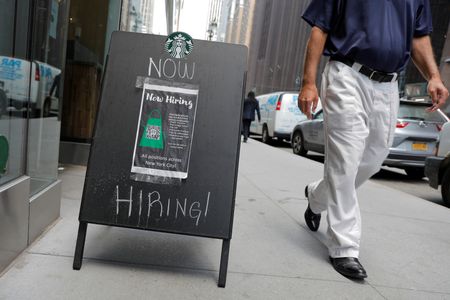By Lucia Mutikani
WASHINGTON (Reuters) – The number of Americans filing new claims for unemployment benefits increased to a three-month high last week, suggesting that the labor market was gradually cooling in another boost to the Federal Reserve’s fight against inflation.
The weekly jobless claims report from the Labor Department on Thursday, the most timely data on the economy’s health, also showed unemployment rolls expanding to levels last seen two years ago. The labor market is slowing as higher interest rates curb demand, consistent with slowing economic activity.
It added to data this week showing subsiding inflation and a moderation in consumer spending in bolstering expectations that the Fed’s monetary policy tightening cycle is complete.
Still, the rise in both initial and continuing claims likely does not signal a material shift in labor market conditions. Economists noted difficulties adjusting the data for seasonal fluctuations following an unprecedented surge in applications for unemployment benefits early in the COVID-19 pandemic.
“Further modest progress has been made towards lowering inflation and rebalancing the labor market,” said Conrad DeQuadros, senior economic advisor at Brean Capital in New York. “We have reservations about the seasonal factors, which may have been distorted by claims during the Covid period.”
Initial claims for state unemployment benefits rose 13,000 to a seasonally adjusted 231,000 for the week ended Nov. 11, the highest since August. Economists polled by Reuters had forecast 220,000 claims for the latest week. Claims are in the middle of their 194,000-265,000 range for this year.
Unadjusted claims increased 1,713 to 215,874 last week. There was a jump in filings in Massachusetts and New York, which more than offset notable decreases in Oregon and Georgia.
“Overall the data suggest that the labor market might be cooling but that conditions are not particularly bad,” said Daniel Silver, an economist at JPMorgan in New York. “The initial claims data can be volatile, particularly around holidays like Veterans Day, so we never want to over-react to just one week of data.”
Job growth slowed in October and the unemployment rate rose to an almost two-year high of 3.9%. Conditions remain fairly tight, with 1.5 job openings per every unemployed person in September. Economists at Goldman Sachs said they did not believe that October’s increase in the jobless rate was a bad omen, noting that the rise in the unemployment rate since April has come entirely from an expansion in the size of the labor force rather than a decline in employment.
Stocks on Wall Street were trading lower after Walmart said Americans continued to exercise caution with their spending because of higher prices and borrowing costs.
The dollar fell against a basket of currencies. U.S. Treasury prices rose, with yields approaching two-month lows.
RATE CUT EYED
The recent raft of inflation-friendly data has left financial markets anticipating an interest rate cut next May, according to CME Group’s FedWatch tool. Since March 2022, the Fed has hiked its policy rate by 525 basis points to the current 5.25%-5.50% range.
The number of people receiving benefits after an initial week of aid, a proxy for hiring, increased 32,000 to 1.865 million during the week ending Nov. 4, the highest level since November 2021, the claims report showed. The so-called continuing claims have increased since mid-September.
Most economists have attributed the rise to the difficulties adjusting the data for seasonal fluctuations rather than weakness in the labor market. They expect this to be ironed out when the government revises the data next spring.
While some agreed that the seasonal adjustment was an issue, they also viewed the sustained increase as a sign that more unemployed people were experiencing longer spells of joblessness.
“There is little prospect for re-energized labor demand on the near-term horizon as interest rates are set to remain ‘higher for longer’,” said Kurt Rankin, a senior economist at PNC Financial in Pittsburgh, Pennsylvania. “Fading consumer demand entering 2024 should thus place upward pressure on jobless claims going forward as those enduring layoffs and new job seekers find opportunities less readily available.”
The stream of encouraging inflation readings was extended by a separate report from the Labor Department’s Bureau of Labor Statistics on Thursday showing import prices dropping 0.8% in October, the most in seven months amid a broad decline in the costs of goods. Import prices rose 0.4% in September.
Economists had forecast import prices, which exclude tariffs, falling 0.3%. In the 12 months through October, import prices declined 2.0% after decreasing 1.5% in September. Annual import prices have now dropped for nine straight months.
But manufacturing was bruised by the United Auto Workers (UAW) union strikes against Detroit’s “Big Three” automakers, which depressed motor vehicle production in October
Manufacturing output fell 0.7% last month after rising 0.2% in September, the Fed said in a third report. Economists had forecast factory output dropping 0.3%. Production at factories declined 1.7% on a year-on-year basis in October.
Motor vehicle and parts output plunged 10.0% after sliding by 0.5% in September. The UAW has ended its industrial action at factories owned by General Motors, Ford and Chrysler parent Stellantis. Excluding motor vehicles and parts, manufacturing production edged up 0.1%.
Manufacturing, which accounts for 11.1% of the economy, continues to be hamstrung by the higher rates. A fourth report from the Philadelphia Fed showed factory activity in the mid-Atlantic region contracted further in November, though the pace of decline slowed from October.
Factories in the region were also downbeat about business prospects over the next six months.
“Overall, we still see signs that manufacturing activity, particularly in the durable goods sector, has bottomed and started to pick up again, although this is unlikely to last in an environment of broadly weakening demand,” said Veronica Clark an economist at Citigroup in New York.
(Reporting by Lucia Mutikani; Editing by Chizu Nomiyama and Andrea Ricci)

